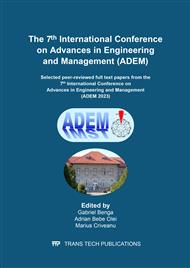p.41
p.51
p.57
p.67
p.75
p.99
p.109
p.123
p.133
Contributions Regarding the Energy Efficiency of Public Buildings through Thermal Insulation
Abstract:
The construction sector is one of the major consumers of energy and non-renewable natural resources, but also an important factor in increasing global warming through the production of greenhouse gases. It is essential to involve and prioritize the energy renovation of buildings, both to increase interior comfort and to reduce the impact on the environment (40% of total energy consumption, 36% of total CO2 emissions, 25-30% of total waste generated) (Valverde et al., 2013) [1]. Amending Directive (EU) 2018/844 requires EU countries to develop, by 2050, long-term renovation strategies to support the renovation of residential and non-residential buildings into a building stock with a high level of energy efficiency and decarbonisation. [2]. The purpose of the work is to provide recommendations, to establish the energy performance of a public building-secondary school-x and to substantiate the solutions and measures for its rehabilitation. The objectives of this paper are to study and develop tools for analyzing the energy optimization options of the structural components of buildings and to formulate an efficient and easily approachable framework-procedure for the evaluation of the decision-making process of increasing the energy efficiency of buildings. The energy performance of the building is determined according to a calculation methodology and is expressed by one or more numerical indicators that are calculated taking into account the thermal insulation, the technical characteristics of the building and installations, the design and location of the building in relation to external climatic factors, exposure to the sun and the influence of neighboring buildings, own sources of energy production and other factors, including the indoor climate of the building, which influence the energy requirement. The techniques used consist in the determination of heat losses through glazed surfaces and opaque surfaces. The results showed that through the package of measures applied, the primary energy consumption was reduced by 56.38%, the annual primary energy consumption 94.49 [kwh/m2, year], and the CO2 equivalent emission index = 18.44 [kgCO2/m2, year].
Info:
Periodical:
Pages:
75-95
Citation:
Online since:
May 2025
Authors:
Price:
Сopyright:
© 2025 Trans Tech Publications Ltd. All Rights Reserved
Share:
Citation:


